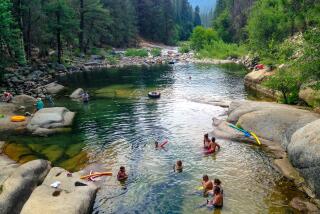Returning Home to Contemplate the Change
- Share via
SAN DIEGO — It’s time to get a life. After three months on the road, exploring America on a recession-style budget, we arrived home with a few dollars remaining in the adventure bank account and a wonderful souvenir.
But if you asked us to travel the 12,437 miles again, the answer would be: “No!”
The challenge for a family of four to drive through 28 states in an un-air-conditioned sedan on $40 a day is a once -in-a-lifetime experience.
This was no pool-side, cocktail-sipping holiday. We spent 57 days in a tent. It rained, it snowed, there were tornadoes, heat waves, biting bugs, fighting children and times when we wanted to go home early.
But we made it, and we were not alone. We met many people, mostly retired couples in RV’s, traveling the country and living out their dream of seeing America from the road.
Among our special moments: a cool night camped under an explosion of stars beneath the Rocky Mountains in Montana . . . when Henri tells us he will remember this day forever after an exciting non-stopstop sightseeing tour of New York City . . . an Oklahoma family that scared us to death by baking a birthday cake and delivering it to our tent in the middle of the night.
There was a lot that surprised us.
After becoming accustomed to the crowded cities of Southern California we didn’t expect to find so much open space out there. We never knew there were so many farms. Herds of buffalo still rule the ranges in the Black Hills of South Dakota and it is still possible to have a fabulous and safe day in Manhattan. There are town squares, flags flying and friendly folk sitting on porches in small towns like Wintereset, Iowa and Livingston, Mont.
Like it or not, we couldn’t escape country music or Rush Limbaugh on our AM radio, fast-food places and mosquitoes. We drove past a constant stream of kooky tourist attractions: portable bungee jumping cranes, wooden mazes, “mystery” houses, life-size-dinosaur parks and giant cowboy statues.
We saw a lot--enough to know we have only cut a tiny ribbon of road around the states, and there is much more left to see.
But the biggest surprise was the bottom line. Can a family of four travel America on $40 a day?
Yes!
When we did the calculations after arriving home, we found we spent an average of $37.84 a day, including food, gas, film, lodging, tourist attractions and lots of fishing bait. The final tab for this family’s 90-day trip was $3,405.71.
The key was preparing many of our own meals, staying in state and national park campgrounds where possible and recovering once a week in budget motels.
We were able to save on major hotel bills when friends and family put us up in Phoenix, New York, San Francisco and Los Angeles.
Keeping to the budget was tough, but we found that when we splurged on extras like eating out, we made up for it by cooking inexpensive meals over the campfire.
If we had to do it again there are a few changes we would make:
* Our Toyota sedan did not miss a beat, but it was too small and we would recommend something more roomy, such as a van. Air conditioning would not be a bad idea either. And while we are at it, next time we’d prefer a car CD player with an AM-FM radio for more well-rounded.
* Three months is not enough time to see America, but for a family with small children it is probably a month too long. Henri, age 5, knew the trip would come to an end but Matilda, 3, feared our camping life would go on forever. “I wanna hotel,” she would say.
They missed their friends most and contact with young children was limited to brief encounters at playgrounds in a few campgrounds.
We asked Henri to write down what children should know about going on a long trip like this. “What you really want to see is raccoons, snakes and possums,” Henri suggests. “If you have a tent or camper be sure to have a field or a playground.”
We notice some major changes in the children now. Henri and Matilda are much closer, playing together and often holding hands. Their vocabulary has increased and Henri has a grip on geography and a solid recollection of the journey. They have lost interest in watching television and are happy to entertain themselves. Henri reads to Matilda and both seem content to draw, color, cut paper and play with their toys. The other day, Matilda was talking to us about Niagara Falls and Henri draws pictures from memory of Mt. Rushmore, Yellowstone and New York City.
For us adult explorers, the adventure became an American history lesson and an endurance test. Collecting firewood, carrying water, setting up tents, lifting the children and hiking has made us more physically fit. The daily challenges of travel, such as dodging tornadoes and spending long nights in isolated campgrounds, has left us mentally tougher.
Tough enough to handle our next exciting challenge. In a Motel 6 outside Seattle, Wash., a home pregnancy test turned up positive.
We are really happy. Our baby will be a lasting souvenir of this grand American adventure.
Adventuring on a Shoestring
Here are a few tips on how we made it around America on a small budget:
* Our decision to spend $58 on a membership in the American Automobile Assn. was one of the best investments of the journey. AAA provided us with extensive maps, and when we changed course we were able to get new maps and route-planning assistance at AAA offices. We used their campground guides and tour books constantly even though the prices quoted for hotels and campsites were often understated. There was also peace of mind in knowing that if our sedan broke down in the Mojave Desert, we could get a free tow.
* We relied on our bank ATM card to supply us with money around the country, but learned in Niagara Falls, where machines would not take our card, that it is also important to keep a few hundred dollars tucked away for an emergency.
* In Nebraska, we locked our keys in the car but had attached a spare key underneath the fender that saved us a long walk to a phone booth.
* Leaving at the end of April helped us beat the summer crowds. July and August are the hardest months to get a campsite. As a last resort, we would be sure to arrive at a busy campground early in the morning.
* We kept at least a gallon of water, several healthy snacks and a selection of fruit in the car at all times. Food often helped the children endure a long drive. We shopped daily in supermarkets and avoided fast-food restaurants. We stopped just twice at McDonald’s and once at a Burger King. These were considered extra-special treats by Henri and Matilda.
* We regularly pulled off the road at playgrounds to give the children 15 minutes of “fun time.” We carried coloring books, water colors and journals, and Henri and Matilda brought a small bag of their favorite toys and books. Before we left, we picked up over a dozen small gifts, such as toy binoculars, a pretend cosmetics set and new books to be handed out during the trip as surprises for the children.
* We kept our camping equipment and clothing limited to basic and essential items, and purchased extra clothes, shoes and camping gear on the road as we needed them.
More to Read
Sign up for The Wild
We’ll help you find the best places to hike, bike and run, as well as the perfect silent spots for meditation and yoga.
You may occasionally receive promotional content from the Los Angeles Times.






